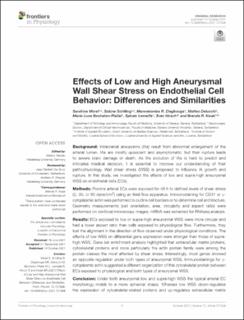Please use this identifier to cite or link to this item:
https://doi.org/10.21256/zhaw-23319| Publication type: | Article in scientific journal |
| Type of review: | Peer review (publication) |
| Title: | Effects of low and high aneurysmal wall shear stress on endothelial cell behavior : differences and similarities |
| Authors: | Morel, Sandrine Schilling, Sabine Diagbouga, Mannekomba R. Delucchi, Matteo Bochaton-Piallat, Marie-Luce Lemeille, Sylvain Hirsch, Sven Kwak, Brenda R. |
| et. al: | No |
| DOI: | 10.3389/fphys.2021.727338 10.21256/zhaw-23319 |
| Published in: | Frontiers in Physiology |
| Volume(Issue): | 12 |
| Issue: | 727338 |
| Issue Date: | 2021 |
| Publisher / Ed. Institution: | Frontiers Research Foundation |
| ISSN: | 1664-042X |
| Language: | English |
| Subjects: | Intracranial aneurysm; Endothelial cell; Wall shear stress; Cell shape; Differential gene expression; Cytoskeleton |
| Subject (DDC): | 571: Physiology and related subjects |
| Abstract: | Background: Intracranial aneurysms (IAs) result from abnormal enlargement of the arterial lumen. IAs are mostly quiescent and asymptomatic, but their rupture leads to severe brain damage or death. As the evolution of IAs is hard to predict and intricates medical decision, it is essential to improve our understanding of their pathophysiology. Wall shear stress (WSS) is proposed to influence IA growth and rupture. In this study, we investigated the effects of low and supra-high aneurysmal WSS on endothelial cells (ECs). Methods: Porcine arterial ECs were exposed for 48 h to defined levels of shear stress (2, 30, or 80 dyne/cm2) using an Ibidi flow apparatus. Immunostaining for CD31 or γ-cytoplasmic actin was performed to outline cell borders or to determine cell architecture. Geometry measurements (cell orientation, area, circularity and aspect ratio) were performed on confocal microscopy images. mRNA was extracted for RNAseq analysis. Results: ECs exposed to low or supra-high aneurysmal WSS were more circular and had a lower aspect ratio than cells exposed to physiological flow. Furthermore, they lost the alignment in the direction of flow observed under physiological conditions. The effects of low WSS on differential gene expression were stronger than those of supra-high WSS. Gene set enrichment analysis highlighted that extracellular matrix proteins, cytoskeletal proteins and more particularly the actin protein family were among the protein classes the most affected by shear stress. Interestingly, most genes showed an opposite regulation under both types of aneurysmal WSS. Immunostainings for γ-cytoplasmic actin suggested a different organization of this cytoskeletal protein between ECs exposed to physiological and both types of aneurysmal WSS. Conclusion: Under both aneurysmal low and supra-high WSS the typical arterial EC morphology molds to a more spherical shape. Whereas low WSS down-regulates the expression of cytoskeletal-related proteins and up-regulates extracellular matrix proteins, supra-high WSS induces opposite changes in gene expression of these protein classes. The differential regulation in EC gene expression observed under various WSS translate into a different organization of the ECs’ architecture. This adaptation of ECs to different aneurysmal WSS conditions may affect vascular remodeling in IAs. |
| URI: | https://digitalcollection.zhaw.ch/handle/11475/23319 |
| Fulltext version: | Published version |
| License (according to publishing contract): | CC BY 4.0: Attribution 4.0 International |
| Departement: | Life Sciences and Facility Management |
| Organisational Unit: | Institute of Computational Life Sciences (ICLS) |
| Published as part of the ZHAW project: | AneuX |
| Appears in collections: | Publikationen Life Sciences und Facility Management |
Files in This Item:
| File | Description | Size | Format | |
|---|---|---|---|---|
| 2021_Morel-etal_Aneurysmal-wall-shear-stress.pdf | 2.83 MB | Adobe PDF |  View/Open |
Show full item record
Morel, S., Schilling, S., Diagbouga, M. R., Delucchi, M., Bochaton-Piallat, M.-L., Lemeille, S., Hirsch, S., & Kwak, B. R. (2021). Effects of low and high aneurysmal wall shear stress on endothelial cell behavior : differences and similarities. Frontiers in Physiology, 12(727338). https://doi.org/10.3389/fphys.2021.727338
Morel, S. et al. (2021) ‘Effects of low and high aneurysmal wall shear stress on endothelial cell behavior : differences and similarities’, Frontiers in Physiology, 12(727338). Available at: https://doi.org/10.3389/fphys.2021.727338.
S. Morel et al., “Effects of low and high aneurysmal wall shear stress on endothelial cell behavior : differences and similarities,” Frontiers in Physiology, vol. 12, no. 727338, 2021, doi: 10.3389/fphys.2021.727338.
MOREL, Sandrine, Sabine SCHILLING, Mannekomba R. DIAGBOUGA, Matteo DELUCCHI, Marie-Luce BOCHATON-PIALLAT, Sylvain LEMEILLE, Sven HIRSCH und Brenda R. KWAK, 2021. Effects of low and high aneurysmal wall shear stress on endothelial cell behavior : differences and similarities. Frontiers in Physiology. 2021. Bd. 12, Nr. 727338. DOI 10.3389/fphys.2021.727338
Morel, Sandrine, Sabine Schilling, Mannekomba R. Diagbouga, Matteo Delucchi, Marie-Luce Bochaton-Piallat, Sylvain Lemeille, Sven Hirsch, and Brenda R. Kwak. 2021. “Effects of Low and High Aneurysmal Wall Shear Stress on Endothelial Cell Behavior : Differences and Similarities.” Frontiers in Physiology 12 (727338). https://doi.org/10.3389/fphys.2021.727338.
Morel, Sandrine, et al. “Effects of Low and High Aneurysmal Wall Shear Stress on Endothelial Cell Behavior : Differences and Similarities.” Frontiers in Physiology, vol. 12, no. 727338, 2021, https://doi.org/10.3389/fphys.2021.727338.
Items in DSpace are protected by copyright, with all rights reserved, unless otherwise indicated.